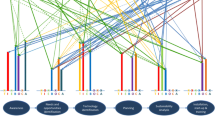Abstract
This paper compares how analyses of energy use and efficiency have developed in households and industrial small- and medium-sized enterprises (SMEs). I focus on earlier studies that use lifestyle categories in examining household energy use, comparing them with studies of mainly Swedish industrial SMEs using the barrier concept in understanding energy efficiency. The main question is how the use of lifestyle categories in household research can be adapted to industrial SMEs. The rationale for using doing this is to find a new way to approach industrial energy use that can give new insight or raise new questions. Lifestyle categories capture the energy culture of a company, including how energy is perceived and what habits and routines are like. Lifestyle categorisation complements barrier analysis, deepening our understanding of how and why companies improve energy efficiency. Using lifestyle categories in an analysis can help policy makers, who can then direct specific policies to particular segments of companies.
Similar content being viewed by others
References
Aune, M. (1998). Nöktern eller Nytene. Energiforbuk og Inverdagsliv i norske husholdninger. Norway: Trondheim (Report no 34. Senter for teknologi og samfunn).
Aune, M. (2007). Energy comes home. Energy Policy, 35, 5457–5465. doi:10.1016/j.enpol.2007.05.007.
Aune, M., Berker, T., & Sørensen, K. H. (2002). Needs, roles and participation: A review of social science studies of users in technological design. Trondheim, Norway: NTNU, Department of Interdisciplinary Studies of Culture.
Carlsson-Kanyama, A., & Lindén, A. (2002). Hushållens energianvändning: Värderingar, beteenden, livsstilar och teknik—en litteraturöversikt. Lund, Sweden: Lund University.
Christoffersen, L.-B., Larsen, A., & Togeby, M. (2006). Empirical analysis of energy management in Danish industry. Journal of Cleaner Production, 14, 516–526. doi:10.1016/j.jclepro.2005.03.017.
Edén, M. (1991). Starta energihushållning i småindustriområden: Hur företagare påverkas av energirådgivning. Gävle, Sweden: BFR (Byggforskningsrådet report no. R41:1991).
Gebremedhin, A., & Palm, J. (2005). Energianalys Borås. Eskilstuna, Sweden: SEA (Report no. ER2005:28).
Hallin, P.-O., & Petersson, B. Å. (1986). De glömda aktörerna. Stockholm: Energiforskningsnämnden (Efn/AES report 1986:1).
Lindén, A.-L. (2004). Miljömedvetna medborgare och grön politik. Stockholm: Formas.
Persson, A. (1990). Nyttiga lärdomar: Erfarenheter av industriell energirådgivning. Stockholm: SIND.
Rohdin, P., & Thollander, P. (2006). Barriers to and driving forces for energy efficiency in the non-energy intensive manufacturing industry in Sweden. Energy, 31, 1836–1844. doi:10.1016/j.energy.2005.10.010.
Rohdin, P., Thollander, P., & Solding, P. (2007). Barriers to and drivers for energy efficiency in the Swedish foundry industry. Energy Policy, 35, 672–677. doi:10.1016/j.enpol.2006.01.010.
Russell, C. (2006). Energy management pathfinding: understanding manufacturers’ ability and desire to implement energy efficiency. Strategic Planning for Energy and the Environment, 25, 20–54.
Sandberg, P. (2004). Optimization and co-operative perspectives in industrial energy systems. Doctoral dissertation. Linköping Institute of Technology, Linköping, Sweden. SEA—Swedish Energy Agency (2004) Energiläget 2004 (Eskilstuna: SEA).
Shove, E. (1998). Gaps, barriers and conceptual chasms: theories of technology transfer and energy in buildings. Energy Policy, 26, 1105–1112. doi:10.1016/S0301-4215(98)00065-2.
Shove, E., Lutzenhiser, L., Guy, S., Hackett, B., & Wilhite, H. (1998). Energy and social systems. In S. Rayner, & E. Malone (Eds.), Human choice and climate change (pp. 291–326). Columbus, OH: Battelle.
Sorell, S., Schleich, J., Scott, S., O’Malley, E., Trace, F., Boede, U. (2000). Reducing barriers to energy efficiency in public and private organizations. Brighton, UK: SPRU-Science and Technology Policy Research.
Thollander, P. (2008). Towards increased energy efficiency in Swedish industry: Barriers, driving forces & policies. Doctoral dissertation. Linköping Institute of Technology, Linköping, Sweden.
Weber, L. (1997). Some reflections on barriers to the efficient use of energy. Energy Policy, 25, 833–835. doi:10.1016/S0301-4215(97)00084-0.
Acknowledgements
The research for this paper forms part of the research programme ‘Energy choices in households—a platform for change’, funded by the Swedish Energy Agency. I also wish to thank my blind reviewers for their valuable comments on the first version of this paper.
Author information
Authors and Affiliations
Corresponding author
Rights and permissions
About this article
Cite this article
Palm, J. Placing barriers to industrial energy efficiency in a social context: a discussion of lifestyle categorisation. Energy Efficiency 2, 263–270 (2009). https://doi.org/10.1007/s12053-009-9042-1
Received:
Accepted:
Published:
Issue Date:
DOI: https://doi.org/10.1007/s12053-009-9042-1




